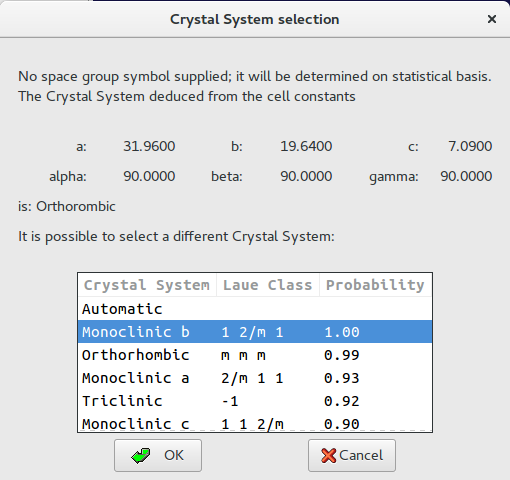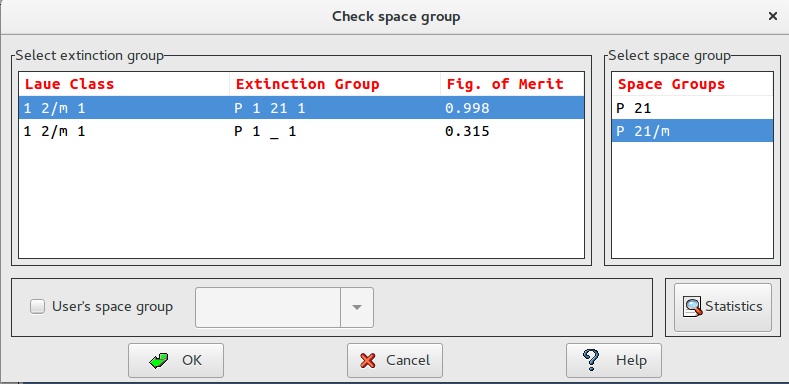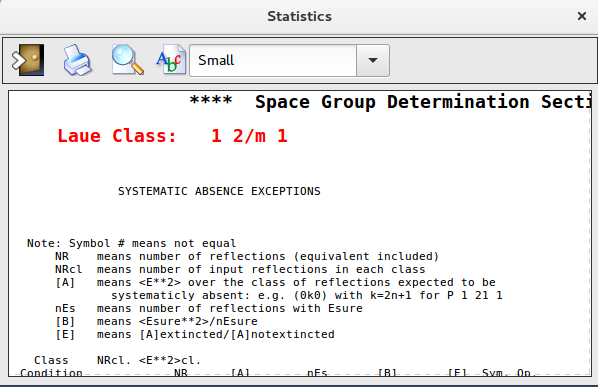This routine reads the basic crystallographic information like cell parameters, space group symbol, unit cell and/or sequence content and diffraction data. It includes a modified version of the subroutine SYMM (Burzlaff & Hountas, 1982). Symmetry operators and information necessary to identify structure invariants (estimated in the INVARIANTS module) are directly derived from the space group symbol.
Diffraction data are checked in order to merge equivalent reflections, to find out systematically absent reflections (which are then excluded from the data set) and, eventually, (weak) reflections not included in the data set (Cascarano et al., 1991).
Diffraction intensities are normalized using the Wilson Method (Wilson, 1942). Statistical analysis of intensities is made in order to check the space group correctness, to suggest the presence or absence of the inversion centre and to identify the possible presence and type of pseudotranslational symmetry (Cascarano et al., 1988 a,b; Fan et al., 1988). Possible deviations (of displacive type) from ideal pseudotranslational symmetry are also detected. Up to 4000 large reflections (those with the largest |E| values) are selected for invariants calculations (if MDM or SDM approach is required); their number (Nlarge) is automatically settled by the program.
When the space group is ambiguous it is possible to derive the Laue class, the extinction group and the space group symbol through the statistical analysis of the observed structure factors.
Procedure to select the space group
An algorithm (Camalli et al., 2011) has been developed for the automatic identification of the Laue group and of the extinction symbol from diffraction intensities. Its efficient use requires the presence of all the measured reflections in the experimental data, weak and potentially extincted reflections included.
The algorithm has statistical basis, is of general use, and has been specialized for electron data. It tries to face the severe problems arising from the often non-kinematical nature of the diffraction intensities, from the limited accuracy of the lattice parameters determined via electron diffraction and from the limited amount of measured intensities.
Since the accepted unit cell may show a lattice symmetry higher than the true one, all the crystal systems with unit cells compatible with that experimentally estimated (we will call them feasible systems) are taken into considerations for the next steps. For example, in case of a cell with cubic geometry, tetragonal, orthorhombic, monoclinic and triclinic systems are considered feasible, hexagonal and trigonal are excluded.
In the following example, the cell constants are orthorombic, but the true space group, as suggested by the program, is P 21/m.
In the first image, the correct Crystal System has the maximum probability value.

In the second image, the Laue Class is “1 2/m 1” and the Extinction Symbol “P 1 21 1” has the higher value of the Figure of Merit; the corresponding possible space groups are shown. The button “Statistics” provides details about the calculations related to all the possible Laue Classes for this structure.
To get help click on ![]()


Often the same extintion symbol is compatible with several space groups. A special directive (i.e. “SPACEGROUP SCAN”, available also through the graphic interface) has been introduced, which enables to consecutively explore all the allowed groups (belonging to the most probable extinction group) to make faster the crystal structure solution. The routine ends with a list of ordered crystallographic residuals, to allow the user to definitively choose the space group and pass to the structure refinement step.